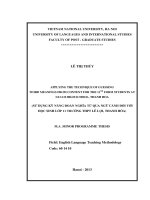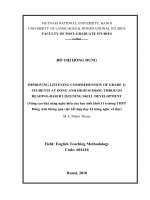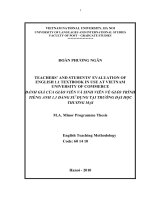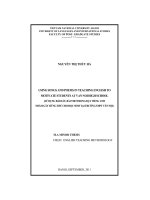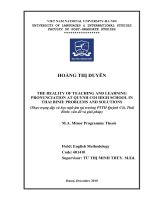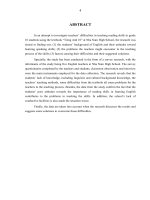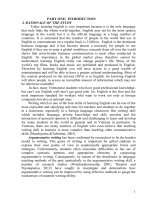Motivating and enhancing students at lang chanh high school to learn english by groupworks
Bạn đang xem bản rút gọn của tài liệu. Xem và tải ngay bản đầy đủ của tài liệu tại đây (226.84 KB, 18 trang )
THANH HOA DEPARTMENT OF EDUCATION AND TRAINING
LANG CHANH UPPER- SECONDARY SCHOOL
EXPERIENCE INITIATIVE
motivating and enhancing students at Lang
Chanh High School to learn English by
groupworks
The writer: Pham Thi Nghi
Position: Teacher of English
Experience initiative: English
THANH HOA 2017
OUTLINE
I. Introduction
II. Development
III. Conclusion
CONTENTS
1. Reason for choosing the topic
2. Aims of the study
3. Scope of the study
1. Theoretical background
2. Practical background
3. The solutions
4. The discussion
PAGE
3
3
4
4- 7
7
7- 13
14- 15
1. General summary
2. Suggested approaches to solve
15 - 16
similar problems
IV. References
1. Websites
V. Appendices
1. Surveys
2. Observations
16
DETAILED OUTLINE
Title: Motivating and enhancing students at Lang Chanh High School to learn
English by groupworks.
I. Introduction
1. Reason for choosing the topic
2
- Social development and national renewal is urgently required to improve the
quality of education and training.
- The roles of English: playing a vital role in the development of our society.
- The current curriculum of English.
- Problems students face
- What I have done to solve the problems
- effective solutions
2. Aims of the study
- To introduce how to groupwork and to show the advantages of working in
groups.
- To show how to organise pair and groupwork effectively and how to deal
withinitial problems that may occur.
- To show how groupwork can be used for various classroom activities
- To give teachers confidence in using groupworks themselves.
3. Scope of the study
- The qualitative and quantitave approach
II. Content / Development
1. Theoretical background : The benefits of groupworks
2. Practical background : The reality of quality of English at Lang Chanh High
School.
3. The solutions
4. The discussion
III. Conclusion
1. General summary:
2. Suggested approaches to solve similar problems
IV. References
- Websites
V. Appendices
- Surveys
- Observations
THANH HOA DEPARTMENT OF EDUCATION AND TRAINING
LANG CHANH UPPER- SECONDARY SCHOOL
THANH HOA, 2017
EXPERIENCE INITIATIVE
3
Motivating and enhancing students at Lang Chanh High School to learn
English by groupworks
The writer: Pham Thi Nghi
Position: Teacher of English
Experience initiative: English
I. Introduction
1. Reason for choosing the topic
English, which is the common language in the world, is an important
subject in schools. Being thoroungly awared of the importance of this language
in international communication as well as in the development of international
integration, Vietnamese educators should use English as the key subject .
English is essential for not only the tourism industry, foreign trade, foreign
companies, computer users but also the high school graduates. Therefore, each
student attending high school must have a certain level of English to prepare for
exams and after graduating at least they are able to communicate, read and write
some normal texts. To do this, we are constantly innovating teaching methods
and curriculum to achieve substantive results for general English courses and
forging some basic skills for students.
During English teaching and learning process, finding the way to obtain
English knowledge is the most important. Groupwork is one of the most useful
one to help students obviously.One of the most important reasons is unsuitable
methods in teaching and learning. The teachers of English often meet difficulties
in approaching new methods of teaching foreign languages communicatively.
How to organise groupwork or pairwork effectively is also the problem which
they often meet. Recognizing the importance of groupwork and pairwork, I’ve
chosen this topic in the hope of finding out some useful measures in organising
groupwork activities in the class.
2. Aims of the study
In this study, my main interests are:
- To introduce how to groupwork and to show the advantages of working in
groups.
- To show how to organise a groupwork effectively and how to deal withinitial
problems that may occur.
- To show how groupworks can be used for various classroom activities.
- To offer teachers confidence in using groupworks during their lecture by
themselves.
* Scope of the study
4
This study is only concerned with ways of organising activities in the class
rather than with teaching techniques.
II. Contents
1. Theoretical background: The benifits of groupworks
In pairwork , the teacher devides the whole class into pairs. Every student
works with his or her partner, and all the pairs work at the same time ( it is
sometimes called “simultaneous pairwork” ) . Point out that this is not the same
as public or open pairwork, with pairs of students speaking in turn in front the
class. In groupwork, the teacher divides he class into small groups to work
together ( usually four or five students in each group ). As in pair group, all te
groups work at the same time.
Pointed out that pairwork and groupwork are not reaching methods but
ways of organnising the class. They can be used far many different kinds of
activities, and are naturally more suitable for some activities than for others
One of the successful ways, if the teacher is resourceful and skilful enough,
to motivate his/her students to participate in the lesson is to use “pair work” or
“Group work” appropriately.Language is best learned through the close
collaboration and communication among students. This type of collaboration
results in benefits for all or both learners. In fact, learners can help each other
while working on different types of tasks such as writing dialogues, interviews,
drawing pictures and making comments about them, play roles, etc…
The first advantage groupworks offers is that there is more language
practice. Groupworks give students far more chance to speak English. Refer to
the request : working in groups, each student makes seven sentences ( either a
question or an answer). If the excercise were done “round the class”, students
would only say one sentence each, and in a large class many students would say
nothing at all.
The second advantage is that students are more involved : Working in
groups encourages students to be more involved and to concentrate on the tasks.
Refer to the above request : if this discussion were conducted with the whole
class together, it would be dominated by a few students and the others would
lose the interest.
An vital profit is that students feel secure . Students feel less anxious when
they are working “privately” when they are “on show” in front of the whole
class. Obviously, groupworks can help shy students who would never say
anything in a whole-class activity to convey their ideas easily.
The last but not least is that groupworks bring students a chance to help
each other . Groupworks encourages students to share ideas and knowledge. In a
reading activity students can help each other to explore the meaning of the text;
in a discussion activity students can give each other new ideas. In language
5
focus lessons, better students can explain the main points to those who are not
good enough.
Moreover, groupwork benefits for students in some other ways:
Students talk: What is more important in the process of language learning than
speaking? Not much. Putting ESL students in groups gets them speaking up and
practicing the language that they are trying to learn. Speaking is an important
skill, and producing out loud language can be intimidating for nonnative
speakers at any point in their journey. You can minimize the intimidation by
including group work from the very start of your classes. When your students
start speaking in their first ESL classes, it becomes a natural part of who they are
and how they learn, and it fails to be an intimidating feat to delay until later in
their studies.
Students help each other: When group work happens, whether it is in the work
place or the classroom, collaboration is part of the process. Your ESL students
are no exception. When they work in groups you will see that students help each
other learn. Students can answer language specific questions or clarify confusing
points of English in ways that ESL students can understand and you may not be
able to explain. When they help each other, it benefits both of the students
involved. The student with the question will have it answered, and the student
with the answer will remember it better because they have taught it to another
Students challenge each other: Students will be intentional about helping each
other when they work in groups, but they may not realize that they will
challenge each other as well. Studies show that speakers modify their speech to
be more like the people to whom they are talking. That means less accomplished
students will become better speakers just by talking to others more advanced
than them, without help and without pressure.
Students encourage each other: Encouragement between language learners can
happen in many ways. One way encouragement comes is when lower level
students see the accomplishments of higher level students. I have found this to
be true particularly in mixed level classes. When a first year student from Korea
sees a Korean who is nearly fluent in English, he feels good about it. When
students share their experiences as well, one student’s story becomes a blueprint
for success for the other!
Students grow closer to each other: By working together, your students will also
develop relationships with each other. They will share personal opinions and life
goals. They will talk about what they have experienced and what they want most
out of life all in the name of learning a language. When they do, they become
friends. These relationships are important for international students. For students
who travel overseas to study English, having a network of friends is extremely
important. Daily cultural struggles can become overwhelming, and individuals
submerged in a second language need support. Most often, your students do not
6
have family nearby, so their classmates become their family and offer support
and encouragement on a daily basis.
Students use language creatively: Communicative classrooms focus on getting
students to use the language they know to get their meaning across. This is when
creative language happens. Creative use of language makes communication
possible even when speakers may not know the perfect grammar for what they
are trying to say, and nothing is more true to life than that. When students work
in groups, they have to work together to accomplish a goal. Even when grammar
takes a backseat in these collaborations, communication happens, and that will
give your students a dry run for when they have to face communication in the
English speaking world.
Students develop cultural sensitivity: When teaching a class of international students,
I will see just how much culture affects a person’s beliefs, values and
expectations. Some ESL students have never known a person from another
culture, and your class will be an opportunity to know people from all over the
world. That means encountering individuals with different values, expectations
and beliefs. When your students can accept and appreciate their classmates, they
will be on their way to doing the same for people all over the world.
In particular, groupwork benefits for teachers as well:
Groupwork activates different learning styles: Part of teaching is reaching as many
different learning styles as possible. One of those learning styles is social, also
known as interpersonal. Students who learn this way work well with others and
benefit from working things out with groups. When you assign group work and
give students goals to accomplish during their time together, these students
flourish.
Getting authentic performance for assessments: It can be hard for ESL teachers to
assess speaking performance in their students. Putting students in groups and
unobtrusively listening to them is a perfect way to see how much they are really
putting to use. You can hear pronunciation, spoken grammar, and ability to
communicate just by listening in on some classroom group work.
Knowing what students are getting and what I need to clarify: When you are teaching
grammar in isolation, it’s easy for students to follow a pattern and fill in the
blanks. When you have your students working together, talking together, using
the right grammar isn’t as predictable as it is in isolated exercises. When you
listen to your students’ performance during group work, you can see what
concepts they aren’t getting and that you may need to explain again. If you are
unsure whether they have really understood a particular language strategy,
assign a group task that will elicit it and listen closely.
7
2. Practical background: The reality of quality of English at Lang Chanh
High School.
There are more than 1,000 students coming from various villages in Lang
Chanh district. Most of them are ethnic minority students, whose background is
not good enough, and they have shy characteristics . That requires teachers to
be enthusiastic and patient in order to find out the most suitable and effective
teaching methods.
In recent years, the implementation of innovation of teaching method in
lang Chanh High school in general, in Foreign Language group particularly has
initially gained encouraging results. The majority of teaching lessons are taught
using active appropriate teaching methods for each skill lessons and different
units, such as: Pair-work, Group work, role-play, centered Learner- ... Choosing
teaching methods depends on the topic of the lesson and students. From what I
have done, I found the practical methods of using teamwork (Group- work)
during the hours of English at high schools Lang Chanh so practical. The quality
of school have been gradually raised . Furthermore, English lessons have
attracted more and more students. English lessons are no longer a burden to the
students those are always sitting and listening to the teacher.During the class,
students can discuss with their partners about the content of the lessons.
In general; however, sometimes organizing group activities is not practical
and appropriate enough it. Therefore, I want to talk about how to organiza
groupworks in English lessons effectively, with the aim of contributing to
improving the effectiveness of teaching and learning English.
3. Solutions
a. Definition of groupwork
A technique within the field of social work wherein various groups
(as educational and recreational) are guided by an agency leader to more
effective personal adjustment and community participation
Based Learning is a form of teaching method putting students in a positive
learning environment in which students are appropriately divided into groups .
Cooperation is to help students train and develop working
skills,
communication skills, and to encourage them to learn from each other.
Moreover, working in groups promotes the role and responsibilities, social
activities on the basis of work co-operation. Through group activities, students
can work together with the work that they can not do it themselves in a certain
time. In the method of learning language, group learning is one of the most
effective ways to enhance and maximize the ability to expressm their ideas. For
a long time, Ther has been a tend to have a fear of failure that is a major obstacle
in the communication process of the students. With this program, students can
help each other in terms of learning process, students are under no pressure
8
when they join groups or participate in forums. Teachers can also encompass
abilities abilities of each student, understand the obstacles which helps students
overcome difficulties in the communication process. Although the accuracy of
the language in the process of group discussion is not high, in return the students
have the confidence to express their opinions more.
b. Steps for teaching using groupworks
Step 1. Setting clear expectations for group work
Since group work requires students to draw on a broad range of skills, they
benefit from being given time to consider practicalities, and to plan (Gibbs,
1995). Students should be introduced to practices such as developing ground
rules (relating to personal and professional conduct), which outline the
expectations for participation of group members and consider mechanisms /
roles that underpin effective project management. In doing so they could be
encouraged to reflect on what they bring to the group (academically and
practically), or on past experiences of group work and how they could learn
from these.
Practical pointer: In a taught session introduce students to the different
stages of group work, and get them to develop strategies for working through
these: familiarisation (with one another / the task), planning and preparation
(identify expertise / tasks / build an action plan), implementation (management
of the activity / keeping in touch) and completion (working toward the product /
deadlines / editing).
Step 2. Thinking carefully about group size and composition
Careful consideration should be given to group size, particularly in relation
to the purpose of the work and the task assigned. Group size influences student
engagement and getting this right engenders desired behaviours to minimise
issues such as freeloading (Seethamraju & Borman, 2009). The optimal group
size is cited as been between four and six people, as this allows students to
develop a sense of identity and ownership (Kerr & Bruun, 1983). Determining
whether group membership is allocated by a tutor, randomly allocated or selfselected depends on the purpose of the group work. Although research is unclear
on the benefit of each approach (Huxham & Land, 2000; Seethamraju &
Borman, 2009) with regards to student learning, tutors need to dedicate time for
the preparation stages even if group members are known to one another.
Practical pointer: Using a range of approaches to group allocation on
different occasions can be beneficial. Membership could be allocated based on:
academic achievement / skill set – however, this requires tutors to have prior
knowledge of the students; criteria such as age, discipline, or name. In
determining the approach taken to allocating group membership consideration
should be given to the purpose of the task and the academic stage.
9
Step 3. Helping manage the logistics of group work
Students have increasingly busy lives and it is common for them to be
balancing a range of commitments alongside their studies, therefore finding time
and space to work in can be perceived as challenging. This can lead students to
complain about logistical issues that threaten to undermine group work (Hillyard
et al., 2010). Tutors should consider how they can mitigate issues relating to
communication, meeting up and accessing resources as they plan group work
and introduce management strategies to students.
Practical pointer: Tutors could timetable classroom space for students to
use; encourage students to set up email distribution lists, schedule a timetable of
meeting dates, recommend technology which can be used for communication
and conducting their work e.g. google.docs, dropbox, institutional wiki or
discussion boards. If appropriate this may feed into the assessment of the group
work.
Step 4. Encouraging intercultural group work
International students embrace group work as an opportunity to interact
directly with home students, yet the mixed responses of home students to
intercultural groups can be a source of disappointment (Cotton et al., 2013; Volet
& Ang, 1998). Students from many countries prefer to work in homogenous
groups, but over the longer term intercultural group working has been
recognised as more beneficial (Gibbs, 2010). Students may need to be prepared
to mitigate some of the complexities of intercultural group settings e.g.
perceived value of student contributions, respectful communication and the risk
that non-native English speakers are disadvantaged. When introducing group
work tutors should explain the importance of cross-cultural collaboration
(Wisker, 2000).
Practical pointer: Design the group work to address a theme, topic or
activity that is unfamiliar to all participants so that no individual is perceived as
having the advantage or as Montgomery (2008) describes make all students
‘equally unsure’; Encourage a structured approach to discussion to give all
group members a chance to speak.
Step 5. Designing innovative group work activities
Most group work involves students working toward a task or end-product
that has been designed as a group activity. However, a common frustration with
group work is that these tasks can be poorly conceived, in that they do no
challenge or require the collective effort of all group members, or are poorly
articulated to students (Hillyard et al., 2010). Group work activities should be
sufficient in size and complexity to require the collective knowledge and effort
of all group members (Gibbs, 1995). Equally they should be authentic in relation
to the intended learning outcomes and beneficial to student learning.
10
Practical pointer: Group work activities should address a complex problem
or issue that requires them to work collaboratively and employ a range of skills
(e.g. negotiation, project management, effective organisation) as well as draw on
the breadth of academic knowledge the group possesses. Build terminology in
the assessment brief / learning outcomes that encourage collaboration and group
work (e.g. compile, collate, compare, discuss). External parties, e.g. employers,
could be invited in to set ‘real world’ questions or projects.
Step 6. Monitoring the groups’ activities
For the students and the tutor it can be beneficial to integrate mechanisms
of monitoring group work. This can make students aware of whose
responsibility managing group work is and encourage them to consider
explicitly how to manage group work, and for the tutor it can provide evidence
of the group’s activities. This evidence could subsequently be drawn upon in
cases where a group has become dysfunctional or as part of the evidence used to
assess group work. Mechanisms could include students creating a diary or
schedule of meetings, recording minutes and action points that capture progress.
Practical pointer: Introduce and explore with students common roles taken
on in meeting situations e.g. meeting chair / facilitator, record or note keeper,
time-keeper and task manager, and how these are used to manage group projects.
If appropriate these records may feed into the assessment of the group work.
Include details in the module handbook that informs students of what to do if the
group is not working well.
Step 7. Managing assessed group work
The assessment of group work is a contentious issue that shapes the level of
student engagement and determines the quality of that learning that takes place
(Gibbs, 2010 (Lejk, Wyvill, & Farrow, 1997). This reflects the complexity of
assessing group work; tutors need to consider whether they are assessing the
product of group work, the process that has led to this product or both the
product and the process (Gibbs, 2010). There is the potential to assess students’
individual and / or collective contributions to the group work. Equally group
work lends itself to a range of assessment mechanisms e.g. tutor, peer or selfassessment. The approach taken to assessing group work needs to be determined
in relation to module learning outcomes and the tutors’ rationale for using group
work. For a detailed discussion of assessing group work, please see the
Plymouth University Guidelines for Assessing Group Work.
Practical pointer: Introduce the format for assessment at the beginning of
the module, outlining clearly the rationale for group work with respect to the
mode of assessment. Ensure students know how marks will be allocated, and if a
novel assessment methodology (e.g. posters / viva) is to be used give students
the opportunity to rehearse through a formative feedback stage.
11
c. Some activities used in groupworks
The table below provides some information on a variety of teaching
methods that are suitable for small group work because they adopt a studentcentred approach. There is no reason why these activities cannot be use in
the online context.
Activity
Description
Ice-breakers See Section 1
Team
building
Examples
See handout ‘Activities and
resources for group work’
Introductory Go round room and have
Name, course, reason why
rounds
students introduce themselves doing this unit of study
Pre-class
quiz
Rounds
Prepare a brief quiz in order
to assess prior learning, skills
and abilities
Ask 10 questions related to
the unit of study (share with
partner/group, maybe
collect?)
Go round group using unit of How do you best learn?
study content or outcomes to Share a high and a low from
stimulate discussion
your last practicum?
(can add an item to pass on or
use a pen and write up
response)
As for rounds but provide
several items related to the
content for students to talk
Choose an
about. Alternatively use
item
unrelated items in order to
encourage conceptual
thinking
A poem, bone, organ, piece
of equipment, book, can of
food Use de Bono’s cards to
form concepts between
items
Provide a cue, concept,
Brainstorm question or idea in order to
ing
generate a list of responses,
options and suggestions.
Brainstorm ‘masculinity’
12
Activity
Description
Start with a brainstorm but
Mind,
broaden the map by seeking
concept or
links between concepts or
topic maps
expanding them.
Examples
Read the book Princess
Smarty Pants and develop a
mind map of the issues the
book explores
Conduct a SWOT analysis
of the issues facing your
group in your upcoming
project
SWOT
analysis
Use a grid with the headings
STRENGTHS,
WEAKNESSES,
OPPORTUNITIES and
THREATS
to generate (brainstorm or
map) ideas about a topic,
question or issue. Used to
identify and address aspects
of the issue
Buzz group
Students join small groups to
discuss ideas, comments,
What are five things you got
from today’s lecture?
d. Some images and results
I show what I've done through some pictures below.
13
- Results
Group 10A2 : The total number of students is 38
The first mid-term
The second midterm
Very
good
02
(5%)
10
(27%)
Good
Average
10
(27%)
20
(52%)
15
(39%)
8
(21%)
Below average
11
(29%)
0
Group 10A5 : The total number of students is 41
The first midterm
The second midterm
Very good
Good
Average
01
(2%)
05
(12%)
05
(12%)
12
(29%)
15
(37%)
21
(51%)
Below
average
20
(49%)
03
(8%)
14
4. The discussion
During the teaching process, I have coped with some challenges. Therefore,
some strategies mentioned below are how to deal with.
a. Students only speak in Vietnamese
Strategies:
- Teacher very strict about English- only in the classroom.
- Close monitoring of pair work & group work.
- Providing incentives for students/groups who only use English in class - candy,
extra homework
b. Students make too much noise. Sometimes they are out of control
Strategies:
- Use a “quiet signal” to maintain control. It can be raised hand, a clap, light turn
off/on
- Set strong and clear guidelines about classroom behavior from the beginning
- Assign a student monitor(s) to keep control
c. Students don’t complete activity; they are bored
Strategies:
- Know your learners! Always search for choose and design group work
activities with their motivation in mind.
- Each student given a “job” in the group - ex. Secretary, spokesperson, task
control, etc
- Follow-up reports, summaries to be
d. Some students don’t participate
Strategies:
- Give students who generally don’t participate the job of “spokensperson” in
the group
- Use “toothpicks” as a tool to control participation. Each student receives 6 and
must use 1 toothpick every time they speak
- Pair up two “quiet” students together
e. Students don’t understand directions
Strategies:
- Prepare and practice giving simple, clear instructions. Repeat many times.
- If students really don’t understand, it’s okay to use Portuguese, but try to avoid
it
15
- Have one student who understands,
f. One group finishes before the others
Strategies:
- Prepare a back-up activity for groups who finish early
- Use members of fast group as “teacher helpers” for the groups with difficulties
- Carefully check over group’s completed work and correct or have them expand
on ideas
In conclusion, Group work is an effective way of learning and
cooperation with others, and the aim is to learn through group cooperation and
encourage all students to participate in the learning process. This approach is
defined in the classroom as a group (Usually 2-6 people). The members obtain
useful information from each other to extend their knowledge and abilities
through the cooperation. Also this method can be helped by transferring implicit
knowledge to explicit knowledge, and gain some satisfaction by self
improvement and competence through the sharing. This essay is going to
explain some benefits held from the group work experience, and also introduce
two important tips of being successful in group work.
• Group work requires students to ask questions and explain their points of view
to others. This not only assists students to increase the opportunities to apply
their knowledge, but also enhances their interest and ability of learning.
Moreover, it enables them to accept different opinions, extends their insights,
and promotes the sustainability and development of thinking.
• Group work helps to improve learning efficiency. That would refer to every
member of the group to actively participate in the learning process and
activities, each member should have great enthusiasm, and learn from tasks
shared by everyone. Also, it is encouraged that each member should brainstorm,
and to express their point of views. Everyone is also encouraged to share their
efforts and do their best with the energy created, so the problem can be solved.
• Group work can enhance the cooperative feelings among students, and develop
students' interpersonal skills. Group work is a process of exchanging
information and knowledge between students, which refers to the progress of
directing the emotion and senses by communicating and helping others, and
especially understanding the culture differences which refers to different
backgrounds. It should be learned that to take care and help each other by
recognizing their merits and also be tolerant of their shortcomings. Moreover, it
is encouraged to listen with an open mind to learn from others and listen to their
points of view. This will allow each member to integrate themselves into a
collective team, and enhance their collective consciousness.
16
• Group work assists students to develop their self-learning ability. Group work
involves students to participate rather than be bystanders. It encourages the
student who has mastered a certain knowledge and skills to transfer and teach
others who do not have themselves. Students who seek for an outstanding
performance in group work must carefully learn the class material, and read
through the text book analysing its content. Some contents may not be available
in current text books, so it encourages students to find information by searching
on the internet, and also makes some notes. These initiatives improve student
learning, so that it promotes their self-learning abilities.
• Group work broadens the learning space for students. It is a process that
transfers the individual competition to a collaborative group effort.
REFERENCES
76 Ideas for Group Work in English, from Simon Midgely, Raising
Achievement in Schools.
/>
Group Work Lesson Plans, from Lesson Planet.
/>
Jigsaw Group Work, from LeMill, Teemu Leiononen and Hans Põldoja.
/> />rojects/benefits.html
/> /> />
17
STATEMENT OF AUTHORSHIP
I hereby acknowledge that this study is mine. The date and findings
discussed in the thesis are true, used with permission from associates and have
not been published elsewhere.
Thanh Hoa, 5th June , 2017.
The confirmation of the Head –Master
The writer
PHAM THI NGHI
18
